Ever heard of phytogenics preventing protein loss in dairy cows?
Stinking algae pollute the beach of Brittany. But what have nitrogen emissions from ruminants got to do with it? And what role play phytogenics?
Increased feed costs and increasing demands to reduce environmental pollution are a problem for many dairy farmers. One of the most expensive nutrients is protein – but excess protein is excreted unused and thus unnecessarily pollutes the environment. How can this protein loss in dairy cows be prevented?
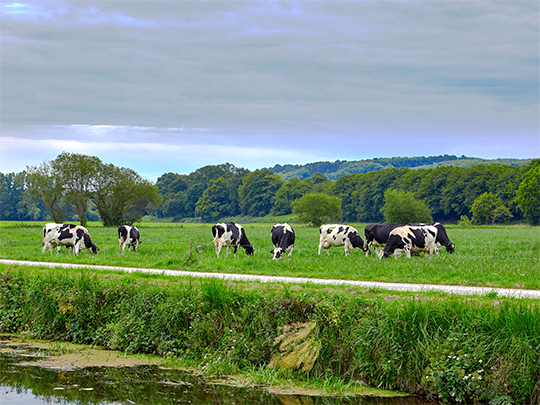
Huge amounts of algae pile up on the beaches of Brittany.
Poisonous, stinking hydrogen sulfide comes out of the rotting, green, thick mush – the beaches are closed due to the deadly danger of the massive quantity of algae. France is fighting desperately against the green plague – caused by local intensive agriculture and rising sea temperatures.
Brittany, best known to produce artichokes and cauliflower, accounts about five percent of total French arable land. However, the region produces 60 percent of pigs, 45 percent of chickens and 30 percent of calves in France. The many rivers and streams in the region allow the nitrate spread with liquid manure to flow rapidly into the sea, resulting in high nitrate concentrations and increased algal blooms.
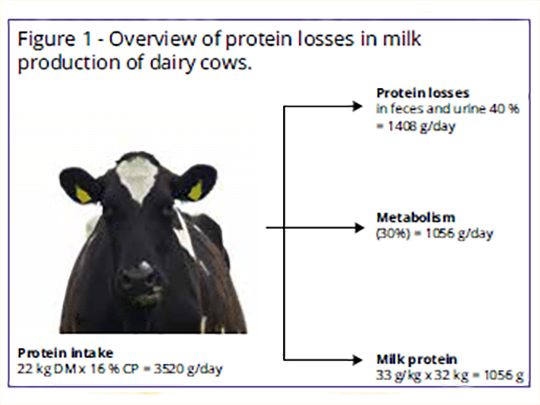
But what helps against high protein losses into the environment?
On the one hand, excessive fertilization must be prevented. However, improved protein efficiency can also counteract the loss of nitrogen in animals – especially in ruminants.
Protein efficiency is expressed as the ratio of milk protein production (in kg/day) to protein intake (kg/day). In dairy cows, protein efficiency is very low compared to monogastric animals such as pigs. Here is an example: A cow that produces 30 liters of milk a day with 3.3% crude protein needs 3.5 kg of dietary protein. This means that less than 30% of the dietary protein is used to produce milk protein. The losses of the feed protein amount to more than 70%, which is due to the urea content in the urine due to excess ammonia in the rumen, indigestible and endogenous excretions in the stool and urine and excretion via the urine due to inefficient use (Fig. 1).
Did you know?
-
Inefficient use of nitrogen by dairy cows leads to higher feed costs and environmental problems due to increased N excretion
-
The well-being of the cow can also be increased by improving protein efficiency: A balanced N supply reduces the risk of energy shortages and has a positive effect on the fertility of the cow
-
Since an oversupply of N is a strain on the liver as the main metabolic organ, a high protein efficiency contributes to the longevity and well-being of the animals
-
An imbalance between protein and energy can weaken the immune system and reduce resilience to diseases
Which are the 3 main areas where protein loss in dairy cows occur?
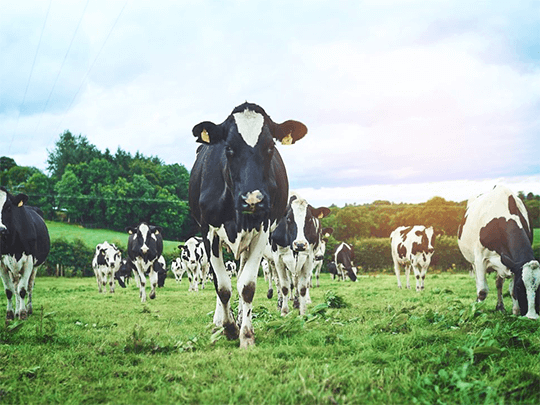
It is firstly the rumen, secondly the small intestine and thirdly the udder and body. The proteins ingested with the feed are first broken down in the rumen into amino acids and peptides, and then converted into ammonia. Ruminal microbes mainly use ammonia and fermentable energy to synthesize their own protein. More than 50% of the metabolized protein in the rumen comes from microbial protein. The microbial protein is carried from the reticulo-omasal orifice into the abomasum and small intestine by the strong influx of fluid with saliva.
However, since high-performance cows are fed with high-quality proteins, the conversion of vegetable into microbial protein and the associated energy consumption leads to undesirable losses in the rumen.
Did you know?
-
the amino acid profile of the microbial protein in the rumen is very well adapted to the production of casein
-
Rumen microbes can also easily use non-protein nitrogen (e.g. urea) to produce essential amino acids
-
Similar to monogastric animals, the ruminal microbiota are digested via pepsin and HCl in the abomasum, so that the microbial amino acids are available for absorption in the small intestine
-
For bypass proteins, i.e. proteins that are hardly degradable in the rumen, protein digestibility in the small intestine is usually between 60 and 90% – depending on the raw material characteristics, the level of the bypass protein arriving in the intestine and the animal status in link with the enzyme capacity
-
Proteins that are not absorbed in the small intestine are excreted with the faeces. The amount is between 10 and 30% of the ingested protein
When you feed a cow, you feed its rumen microbes first and foremost.
So, there are two main sources that contribute to the amino acid pool that arrives at the duodenum of the ruminant:
1. the microbial protein is synthesized in the rumen by microbes and represents the most important amount of the total protein supply of cows with 50-75%.
The microbes build their own valuable body protein from nitrogen and amino acids before they are flushed into the cow’s duodenum. Here they are digested. However, microbes do not only need energy: the microbial protein can only take place if ammonia is also available. Ammonia is produced by the hydrolysis of degradable protein- (or N-) sources and carbon skeletons from fermentable carbohydrates. If there is a lack of energy and excess protein in the rumen, the microbes use protein to produce energy, which leads to a waste of N. A waste that is excreted in the cow’s urine and is reflected in higher urea nitrogen levels in blood and milk. Moreover, to produce amino acids, the microbes need minerals, trace elements and vitamins: for example, we need a ratio of 1:10 between sulfur and nitrogen in the rumen that microbes can produce amino acids.
2. the non-degradable protein (UDP): the part of the feed protein that is not degraded in the rumen and is therefore available to the cow directly in the small intestine.
With regard to the UDP, it is important to ensure that the amino acid balance of the raw materials in the ration is adapted to the needs of the cows. Although high-yielding cows need more UDP to meet their protein needs, it is always the microbial protein that remains the most important source of protein.
How do phytogenics contribute to better protein efficiency?
Of course, feed management is a crucial tool when it comes to avoiding protein losses. In addition to high-quality roughage, optimized rations that support the rumen balance and at the same time provide the cow with the necessary nutrients and proteins in the duodenum are of utmost importance. However, phytogenic additives are a valuable tool when it comes to improving the protein efficiency of ruminants and thus reducing environmental pollution and increasing the well-being of dairy cows. Natural, holistic plant-based formulations of essential oils, saponins, spices and condensed tannins can unfold their effects on three levels in different areas of the digestive tract:

1. Improved energy and protein efficiency ratio in the rumen:
An improved rumen function leads to an improved energy and protein efficiency ratio and increases the proportion of metabolizable bypass protein and microbial protein (the latter shows a very good amino acid balance to build up milk casein). This leads to lower ammonia losses from the rumen, via the liver (where it is converted into urea) into the urine.
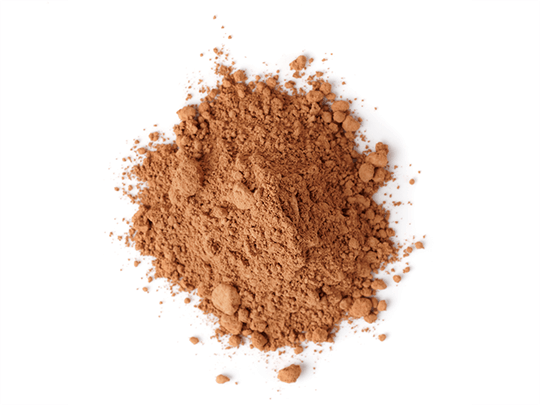
2. reduction of protein degradation in the rumen:
a reduction of protein degradation in the rumen increases the level of the bypass protein and thus reduces protein losses.
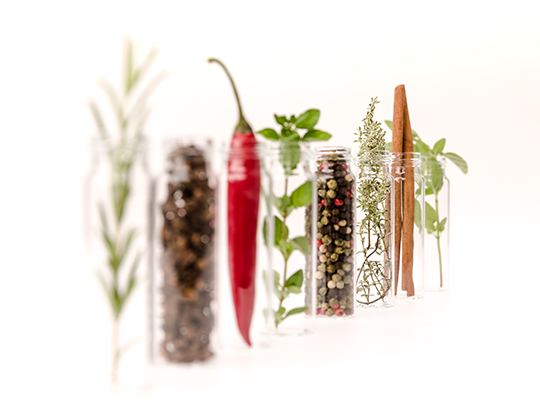
3. improvement of protein digestibility and absorption:
the natural ingredients of selected PFAs have a positive influence on protein digestibility and absorption in the small intestine. By increasing the amount of metabolizable bypass protein and microbial protein, the amount of indigestible protein is minimized. This reduces the protein loss with excrements and the ammonia concentration.
Did you know the crucial difference in protein metabolism between cattle and pigs?

Thierry Aubert
Thierry Aubert can look back on 15 years of experience in the premix, feed and meat industry. Since the beginning of his career, Thierry is in regular exchange with the farmers to understand their challenges and needs. In 2013 he joined Delacon as Species Leader Ruminants. With his team, he is in charge of the global product development for the ruminant species and customer technical support. Since spring 2018, his task areas have been extended: At the moment, he is also responsible for the coordination of the Reginal Technical Managers worldwide. In his leisure time, he likes to go running and already participated in several marathons.










